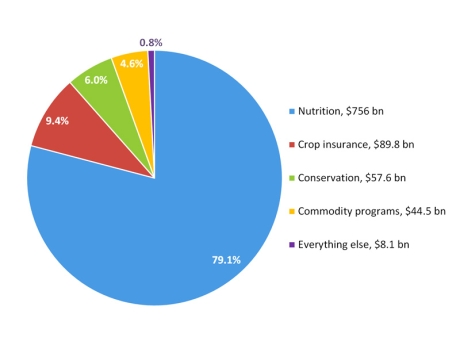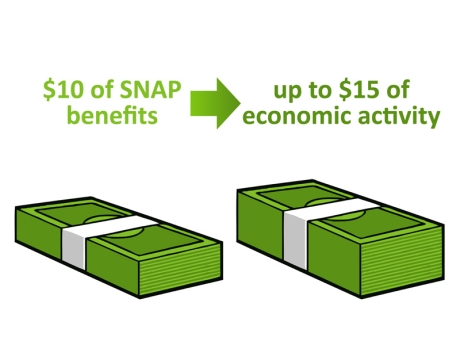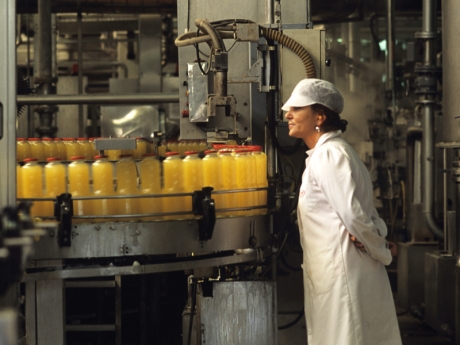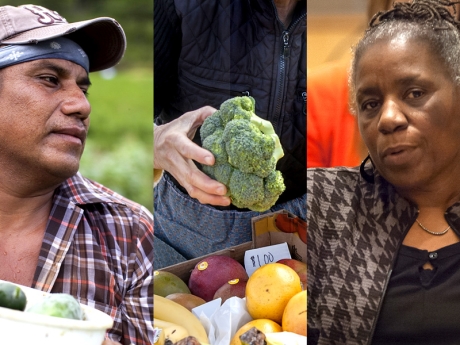Food Policy
Background

U.S. Farm Bill budget, 2014.
The Farm Bill is arguably the most influential piece of legislation on the U.S. food system. Renewed every five years or so, the bill shapes federal involvement in numerous roles, including providing nutrition assistance to low-income families, insuring farmers against crop loss (e.g., from pest outbreaks or unpredictable weather), and incentivizing farmers to conserve soil and wetlands.
Data source: U.S. Congressional Budget Office.2
The policies of local, state, and federal governments determine, to a considerable degree, how we farm and what we eat. Ideally, these policies would help ensure that all people have access to safe, affordable, healthy food; protect our air, water, and land; support the farmers and workers who put food on our tables; and uphold rigorous standards for the welfare of animals used for food. Where these policies fall short, there are opportunities for change. The following is a brief exploration of how selected U.S. federal policies address (or fail to address) several key areas, followed by a discussion of how citizens can get involved to create positive food system change.
If you eat, pay taxes, care about the nutritional value of school lunches, worry about the plight of biodiversity or the loss of farmland … you have a personal stake in the tens of billions of dollars annually committed to agricultural food policies.1
– Dan Imhoff
Supporting Farmers

Depression-era farmers.
If the supply of a product increases while demand remains unchanged, a surplus occurs, leading to a drop in prices. Over the 1920s and 1930s, large surpluses and crippling low prices forced nearly 100,000 farm foreclosures each year. In the words of then Secretary of Agriculture Henry Wallace, "Our surpluses of food crops seem to have had as disastrous an effect upon national well-being as crop shortages used to have on the isolated communities of a simpler age.”3
Photo credit: Dorothea Lange. Public domain.
U.S. federal policies have a long history of influencing agricultural markets—the prices farmers receive for their crops, for example, and the quantities of crops they grow.
The first of such policies was the Agricultural Adjustment Act (AAA) of 1933, when U.S. farmers were producing far more goods than they could profitably sell. This was a problem of agricultural surpluses: as the supply of agricultural goods exceeded demand, the prices farmers received for selling those goods dropped.3 To make a living on deflated prices, farmers responded by producing even more goods, feeding a vicious cycle that further increased surpluses and lowered prices.4 According to one South Dakota lawyer, “Our farmers … did everything possible to raise a maximum crop. ... If they had loafed upon their jobs, and had worked eight hours a day instead of 16, and raised only one-half or two-thirds of a crop, it would have been worth a great deal more than the entire crop which they did produce.”4
In what may have seemed like a counterintuitive plan, the AAA aimed to support struggling farmers by incentivizing them to produce less—leaving some of their cropland fallow (uncultivated), for example, or even plowing under planted crops. The AAA later allowed the federal government to purchase surplus meat, dairy, and grain from farmers and distribute it to the unemployed and hungry. Later versions of the AAA set minimum prices for major crops, such as wheat, to prevent prices from dropping too low. These and other policies helped reduce surpluses, stabilize prices, and support farmers through difficult times.5,6, 4
Although the federal government withdrew its involvement in controlling production and stabilizing prices in 1996,7 many of the ideas pioneered in the AAA live on in what became known as the U.S. Farm Bill (see captions).
Feeding the Hungry

Every $10 of SNAP benefits (food stamps) generates up to $15 in economic activity.
Federal food and nutrition assistance programs can boost the economy. The Supplemental Nutrition Assistance Program (SNAP), for example, encourages participants to spend more on food. Every dollar’s worth of SNAP benefits generates an estimated 17 to 47 cents of additional spending, creating jobs for grocers, farmers, and other businesses.14,15 When SNAP benefits are accepted at farmers’ markets, they have the added benefit of supporting local economies.
Image credit: Brent Kim, Johns Hopkins Center for a Livable Future.
Roughly one in seven U.S. households experiences food insecurity at times during the year. This can mean going hungry because there’s not enough money to buy food, worrying food will run out, or having to rely on food banks or soup kitchens.4 Federal food and nutrition assistance programs like SNAP (food stamps) and Women, Infants and Children (WIC) help low-income families put food on their tables. Funding for SNAP is shaped by the budget of the U.S. Farm Bill (see caption), an important piece of legislation that is not just about farms.
Food insecurity is also a global problem. Worldwide, malnutrition is responsible for nearly half the deaths of children under 5.8 How do U.S. policies affect efforts to address food insecurity in other parts of the world?
Every year, the U.S. government purchases surplus grain from its farmers and distributes it to countries in need. International food aid alleviates hunger, at least in the short term, and can target the most vulnerable populations. Aid programs also support U.S. farmers by reducing surpluses, raising the value of their grain. In areas that receive food aid, however, farmers may see their own prices drop with influxes of donated grain.9–11
In each situation, the pros and cons of sending food aid deserve careful consideration. In some cases, aid programs have been driven not by hunger but by industry pressure to reduce surpluses. In 2001, rice industry representatives successfully lobbied for increases in aid, arguing that “immediate increases in food aid now could mean the difference between survival and financial disaster for rice mills.”12 As an alternative to sending food, the 2014 Farm Bill increased the amount of funds that can be used to purchase food directly from farmers in regions where aid is needed.13
Keeping the Food Supply Safe

The Hazard Analysis and Critical Control Points (HACCP) process is a prevention-based approach required by U.S. Department of Agriculture (for meat) and the Food and Drug Administration (for juice and seafood) that monitors food safety hazards at key points along the supply chain.19 HACCP procedures, for example, might involve checking temperatures during cooking or making sure containers are properly sealed during food packaging.
Photo copyright.
The food supply chain, from farm to plate, is subject to contamination by bacteria, viruses, parasites, toxins, and various chemicals. What are the roles of government agencies in keeping these contaminants out of our food supply?
The U.S. Food and Drug Administration (FDA) and the Department of Agriculture (USDA) work to reduce the risks of foodborne contamination, such as by inspecting processing facilities for signs of contamination, and by requiring producers, processors, restaurants, and other businesses to follow safety protocols. Food safety inspectors may also check food for visible signs of contamination, such as fecal residue on poultry carcasses. In rare cases, samples may be collected for further analysis, to check for contaminants that are missed during visual inspection. Federal agencies are often understaffed, however, and are unable to monitor most of the enormous number of products that enter our food supply.15
If contaminated food makes someone sick and they report it, or if there is a widespread foodborne illness outbreak, the FDA, USDA, and/or Centers for Disease Control and Prevention (CDC) work to identify the source of the illness and control the outbreak by coordinating with local, state, and federal officials. Government agencies may urge or order food companies to recall the contaminated products.
The FDA also has an important role in reviewing drugs and other chemical compounds used in food animal production, including antibiotics. FDA policies have thus far been very permissive in allowing producers to routinely use low doses of antibiotics in animals’ feed and water—a practice that contributes to the development of antibiotic-resistant bacteria, which may spread to people through the environment and via contaminated meat.16
Protecting the Environment

The Clean Water Act was passed in 1972 to regulate the release of pollutants into U.S. waters and set water quality standards. Some agricultural pollutants, such as nutrient runoff, are regulated under the act.
Public concern about water quality helped generate the political will that led to the Clean Water Act. Public awareness heightened in 1969 after a floating oil slick on Ohio’s Cuyahoga River caught fire for at least the 10th time.29
Photo credit: Nicholas A. Tonelli, 2010. Cropped from original. Creative Commons CC BY 2.0.
Agriculture, for better and for worse, has always affected air, water, land, and climate. U.S. farm policies can play important roles in helping conserve resources, reduce pollution, and promote more ecologically sound farming practices.
The U.S. Farm Bill (see caption), for example, offers incentives for farmers to reduce soil erosion and runoff, conserve freshwater, shift to renewable energy sources, preserve wetlands, and protect wildlife habitats.18–21 Other federal policies authorize the U.S. Environmental Protection Agency (EPA) to regulate certain agricultural pollutants. As part of the Clean Water Act, for example, certain industrial food animal production (IFAP) facilities must apply for a permit, which requires the operator to submit a plan detailing the steps they would take to prevent animal waste from polluting ground and surface waters.22,23
Many such policies, however, fall short of their intended goals, often because they have been weakened by industry groups that have a financial interest in avoiding government regulations. The permitting process for IFAP facilities, for example, was watered down by industry pressure and now applies only to the largest facilities that meet specific criteria—those designated as concentrated animal feeding operations, or CAFOs (see caption). Facilities that do not qualify as CAFOs are generally exempt, even if they still threaten water quality. Even among CAFOs, many facilities have avoided applying for permits, or permits were approved without a thorough review. In many cases, water pollution from CAFOs is investigated only after citizens submit complaints.22,23 Other forms of pollution from IFAP operations, including most air pollutants, are not regulated at all.24
Citizen Engagement
Vote with your fork, and even better, vote with your vote.
– Marion Nestle

Food policy councils unite community members with farmers, food distributors, chefs, grocery store owners, policymakers, and other stakeholders in a local, state, or regional food system. These councils look for opportunities to improve the food system, particularly where food security is concerned, and provide policy recommendations to local, state, and federal governments. Persons seeking to become more engaged as “food citizens” may find opportunities through a food policy council.
Photo credits, L to R: Laura Pohl, Bread for the World, Creative Commons CC BY-NC 2.0; Mike Milli, Johns Hopkins Center for a Livable Future; Pete Souza, The White House; Mike Milli.
The popular motto “vote with your fork” expresses the potential for food purchases to send market signals that reflect consumers’ desires, ultimately affecting what, where, and how food is produced, processed, distributed, and sold. For example, consumers can adopt more sustainable eating patterns—such as eating fewer animal products and more plant-based foods—taking into account the downstream public health, social, and ecological consequences of their choices.26 This idea is captured in the words of farmer and author Wendell Berry: “How we eat determines, to a considerable extent, how the world is used.”27
While the collective use of our food dollars can exert economic pressure on the food system, we can exercise even greater change by moving beyond our role as “food consumers” to that of “food citizens.”28 In addition to making informed food choices that reflect their values, food citizens leverage their political power to shape food and agricultural policy.
At the local level, for example, food citizens can work with schools and other institutions to offer healthier and more sustainable food options; or advocate for local zoning laws that encourage farms, gardens, and healthy food stores. Communities facing unwanted health, environmental, or nuisance threats from proposed industrial food animal production (IFAP) operations may respond by working with legal representatives and local government agencies to prevent construction.29 Food citizens can also influence policies at the state and federal levels, for example, by writing letters or calling government representatives to express concern about food system issues.
Citizen involvement has shaped some of the more significant developments in our food system (see captions). Well-informed food citizens who make their voices heard can create positive change.
Resources
The following list of suggested resources is intended as a starting point for further exploration, and is not in any way comprehensive. Some materials may not reflect the views of the Johns Hopkins Center for a Livable Future.
For teachers
- Food Policy in Action (lesson plan). FoodSpan. Johns Hopkins Center for a Livable Future.
- Introduction to the US Food System: Public Health, Environment, and Equity (textbook). Neff RN (editor). Johns Hopkins Center for a Livable Future. 2014.
Reports and other documents
- An Overview of Institutional Food Procurement and Recommendations for Improvement. Fitch C, Santo R. Johns Hopkins Center for a Livable Future. 2015.
- Industrial Food Animal Production in America: Examining the Impact of the Pew Commission’s Priority Recommendations. Johns Hopkins Center for a Livable Future. 2013.
- Food Policy in the United States: An Introduction (book). Parke Wilde. 2013.
- Food Fight: The Citizen's Guide to the Next Food and Farm Bill (book and website). Daniel Imhoff. 2012.
- Putting Meat on the Table: Industrial Farm Animal Production in America. Pew Commission on Industrial Farm Animal Production. 2008.
- Food Policy Networks (website). Johns Hopkins Center for a Livable Future.
Academic journal articles
- A Food Systems Approach to Healthy Food and Agriculture Policy (requires subscription) Neff RA, Merrigan K, Wallinga D. HealthAffairs 2016.
- Interplay between policy and science regarding low-dose antimicrobial use in livestock (open access). Sorensen AC, Lawrence RS, Davis MF. Frontiers in Microbiology. 2014.
- Investigating the Role of State and Local Health Departments in Addressing Public Health Concerns Related to Industrial Food Animal Production Sites (open access). Fry JP, Laestadius LI, et al. PLOS One, 2013.
- Strengthening Vendor Standards in the Supplemental Nutrition Assistance Program: Are Healthier Foods Within Reach? (open access) Kennelly ME, Neff R, Rutkow L. Journal of Health Care Law & Policy. 2013.
- Exploring Food System Policy: A Survey of Food Policy Councils in the United States. Scherb A, Palmer A, et al. Journal of Agriculture, Food Systems, and Community Development. 2012.
- Eating right here: Moving from consumer to food citizen. Wilkins JL. Agriculture and Human Values. 2005.
References
- Imhoff D. Food Fight: The Citizen’s Guide to a Food and Farm Bill. Berkeley: University of California Press; 2007.
- Congressional Budget Office. Letter to the Honorable Frank D. Lucas. January 2014.
- Alston LJ. Farm Foreclosures in the United States During the Interwar Period. J Econ Hist. 1983;43(4).
- Poppendieck J. Breadlines Knee Deep in Wheat: Food Assistance in the Great Depression. Rutgers University Press; 1986.
- Rasmussen WD, Baker GL, Ward JS. A Short History of Agricultural Adjustment, 1933-75. USDA ERS; 1976.
- Saloutos T. New Deal Agricultural Policy: An Evaluation. J Am Hist. 1974;61(2).
- Lauck J. After Deregulation: Constructing Agricultural Policy in the Age of “Freedom to Farm.” Drake J Agric Law. 2000;5.
- World Health Organization. Children: reducing mortality. 2014.
- Tschirley D, Donovan C, Weber MT. Food aid and food markets: lessons from Mozambique. Food Policy. 1996;21(2):189-209.
- Sharaunga S, Wale E. The dis-incentive effects of food aid and agricultural policies on local land allocation in developing countries: The case of Malawi. Dev South Afr. 2013;30(4-05):491-507.
- Isenman PJ, Singer HW. Food Aid: Disincentive Effects and Their Policy Implications. Econ Dev Cult Change. 1977;25(2):205-237.
- Oxfam International. Food Aid or Hidden Dumping? Separating Wheat from Chaff. 2005.
- Schnepf R. International Food Aid Programs: Background and Issues. Congressional Research Service; 2014.
- Hanson K. The Food Assistance National Input-Output Multiplier (FANIOM) Model and Stimulus Effects of SNAP. 2010.
- USDA. The Benefits of Increasing the Supplemental Nutrition Assistance (SNAP) Program Participation in Your State. 2011.
- Maki DG. Coming to Grips with Foodborne Infection — Peanut Butter, Peppers, and Nationwide Salmonella Outbreaks. N Engl J Med. 2009;360.
- Hayes JR, English LL, Carter PJ, et al. Prevalence and Antimicrobial Resistance of Enterococcus Species Isolated from Retail Meats. Appl Environ Microbiol. 2003;69(12):7153-7160.
- Kevin Keener. Safe Food Guidelines for Small Meat and Poultry Processors: Overview of HACCP. Purdue Extension; 2007.
- USDA National Resources Conservation Service. Financial Assistance.
- USDA. Rural Energy for America Program. Rural Dev. 2013.
- USDA Farm Service Agency. Conservation Reserve Program. 2014.
- Johns Hopkins Center for a Livable Future. Protecting Environmental Compliance Programs: A Public Health Priority. 2012.
- Centner TJ. Governmental oversight of discharges from concentrated animal feeding operations. Environ Manage. 2006;37(6):745-52.
- Graham JP, Nachman KE. Managing waste from confined animal feeding operations in the United States: the need for sanitary reform. J Water Heal. 2010; December:646-70.
- Wilson SC. Hogwash! Why Industrial Animal Agriculture is Not beyond the Scope of Clean Air Act Regulation. Pace Environ Law Rev. 2010;24(2).
- Stradling D, Stradling R. Perceptions of the Burning River: Deindustrialization and Cleveland’s Cuyahoga River. Environ Hist Durh N C. 2008;13(3):515-535.
- Gussow JD, Clancy KL. Dietary guidelines for sustainability. J Nutr Educ. 1986;18(1):1-5.
- Berry W. The Pleasures of Eating. In: What Are People For? New York: North Point Press; 1990.
- Wilkins JL. Eating Right Here: Moving from Consumer to Food Citizen. Agric Human Values. 2005;22(3):269-273.
- 36. Head T, III R. Local Regulation of Animal Feeding Operations: Concerns Limits, and Options for Southeastern States. Environ Law. 1999;6(503).
